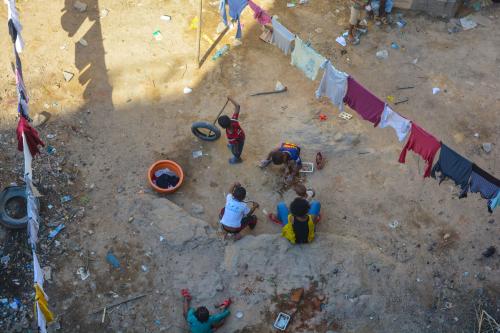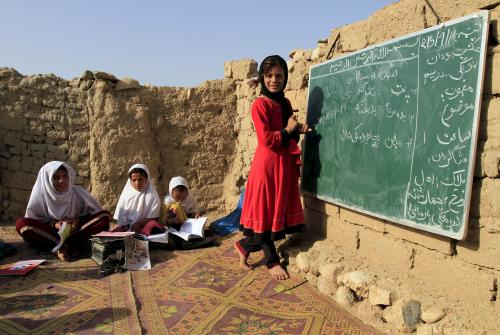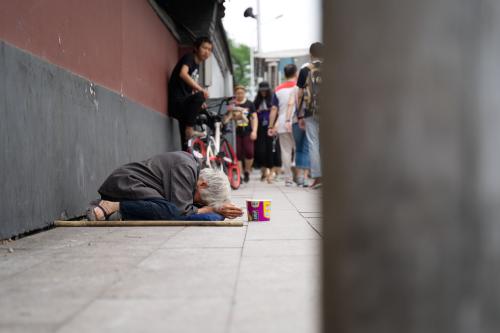The world is experiencing a tipping point in its fight against poverty. By 2022, more than half of the world’s people living in extreme poverty will be living in fragile states, according to projections by World Data Lab. There are currently 39 fragile states that the World Bank classifies as “countries with high levels of institutional and social fragility” and “affected by violent conflict.” They are home to almost 1 billion people, 335 million of which lived in extreme poverty in 2020. Projections by the World Data Lab’s World Poverty Clock suggest that by 2030, there will be 359 million people living in extreme poverty in today’s fragile states, representing 63 percent of the world’s poor (see Figure 1). This means that while most stable countries can anticipate the end of extreme poverty, more than a third of the population in fragile states will live in extreme poverty.
Figure 1. Poverty is declining in most countries, not in fragile states
Source: World Data Lab projections.
Two fragile countries are and will be the focal points for extreme poverty
Geographically, poverty is increasingly concentrated in Africa and success in ending poverty globally will largely depend on African fragile states. Today, four of the top 10 countries with the poorest people are fragile states, while the other six countries are considered relatively stable. By 2030, five fragile states in the top 10 and the top 2 will both be states that are currently experiencing fragility and conflict: Nigeria and the Democratic Republic of the Congo (DRC) (Figure 2).
Figure 2. By 2030, fragile states will make up five of the 10 countries with the highest number of extreme poor
Source: World Data Lab projections.
Note: Venezuela (classified as fragile state) is likely to also be among the countries with one of the highest absolute numbers of extreme poor in 2030. However, due to inconsistencies with demographic and economic projections, it has been left out in this analysis.
The world’s attention to ending poverty needs to focus on fragile states, and within the group of fragile states, two countries stand out: Nigeria and the DRC. They will make up one-third of total extreme poverty in 2030 as the number of the extreme poor in both countries is projected to grow from 152 million to 178 million. This is more than the total increase among all other fragile states combined.
Nigeria is moreover part of a broader region that is experiencing important levels of conflict, fragility, and poverty. Seven out of 10 Sahel countries are currently classified as fragile (Mali, Burkina Faso, Niger, Chad, Sudan, Nigeria, Eritrea), and these seven countries alone are expected to account for 26 percent (147 million) of the total extreme poor in 2030, whereas the non-fragile Sahel countries add only a negligible 2.6 million to that balance. Following Nigeria, the Sahel countries with highest extreme poverty in 2030 will be Sudan (8 million), Chad (7.7 million), and Mali (6.9 million).
By 2030, non-fragile states will inch closer to a reality where extreme poverty is history, yet fragile states will have more people in extreme poverty than ever before. This vulnerability in fragile states has long-term consequences. Fragile states, therefore, need to be a priority not just in the humanitarian context, but also for longer-term development. The concentration of poverty in just a few pockets may otherwise lead to a spiraling effect and something one may call a “fragility trap”—a self-reinforcing trend that keeps the country away from any hope of stability. Moreover, increased poverty increases the risk of conflict, putting fragile states at increased risk of conflict relapse.
Why children should be everyone’s first priority
The probability of being poor or nonpoor will increasingly depend on whether you are born in a fragile state or not. By 2030, 78 percent of non-fragile states will achieve Sustainable Development Goal 1 to end extreme poverty, while only 19 percent of fragile states are expected to achieve this goal. Furthermore, only about half of all fragile states will reduce the absolute number of people in extreme poverty between 2020 and 2030.
As fragile poor states tend to have higher fertility rates than stable countries, they also have a higher share of children in poverty. The data model underlying the World Poverty Clock makes it possible to disaggregate poverty by age, and shows that, for example, half of Nigeria’s 90 million people in extreme poverty in 2021 are children under 15. Equivalently, almost half of Nigeria’s 105 million children live in extreme poverty. These are ratios apparent in most fragile states.
As such, by 2030 two-thirds of the world’s extreme poor will live in fragile states, half of which will be children—and among the children in fragile states, almost half of them will be extremely poor. This means that if a child is born in a fragile state, it has a 50 percent chance to grow up in extremely severe conditions. If a child is born in the rest of the world, the chance of growing up in extreme poverty is less than 5 percent. The prosperity of the next generation will therefore primarily depend on our success in supporting the most vulnerable populations in the most vulnerable geographic areas—potentially requiring more creativity and dedication than ever.
Any questions on the data model should be directed to jasmin.baier@worlddata.io.
-
Acknowledgements and disclosures
Many thanks to Marco Fengler for research assistance for this analysis, which builds on joint work by the Ministry of Foreign Affairs of Denmark and World Data Lab.











Commentary
Poverty and fragility: Where will the poor live in 2030?
April 19, 2021